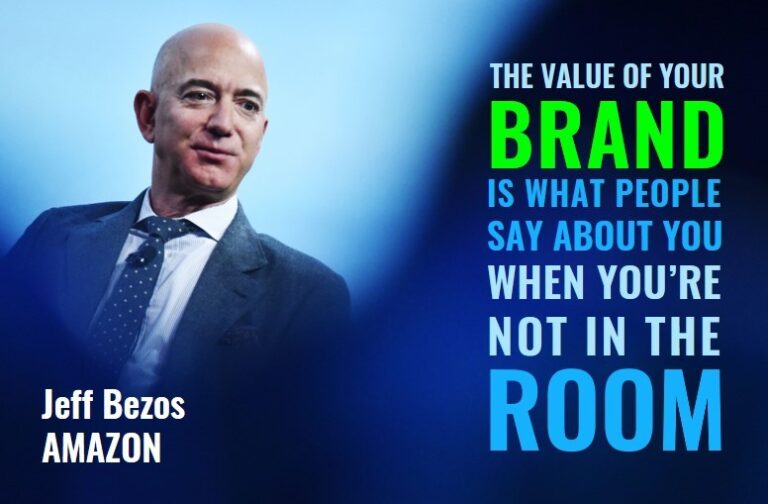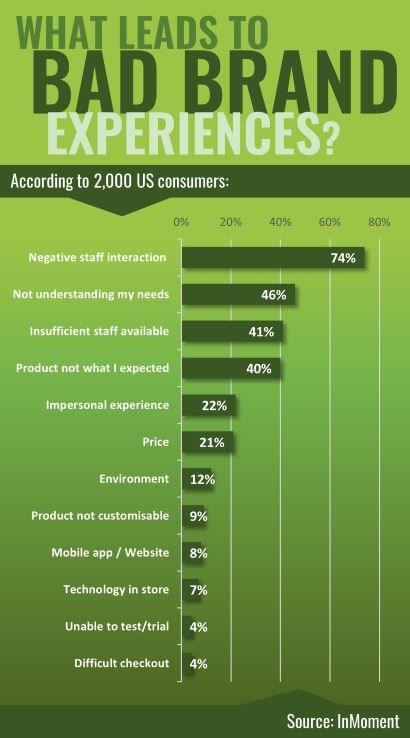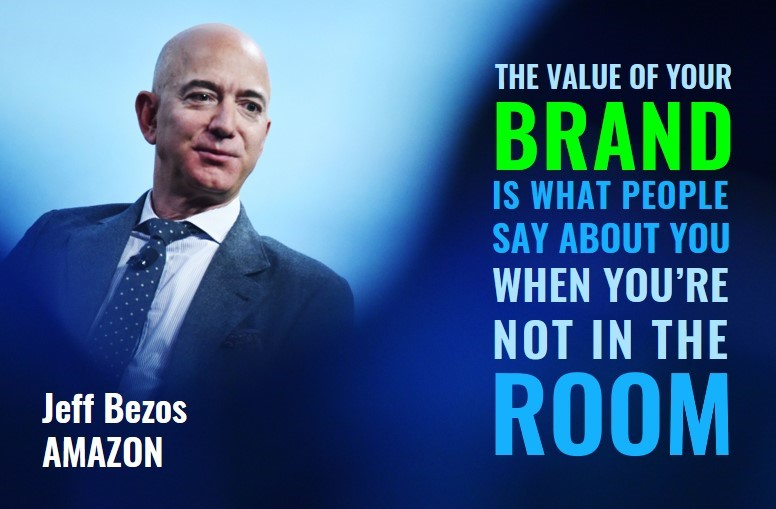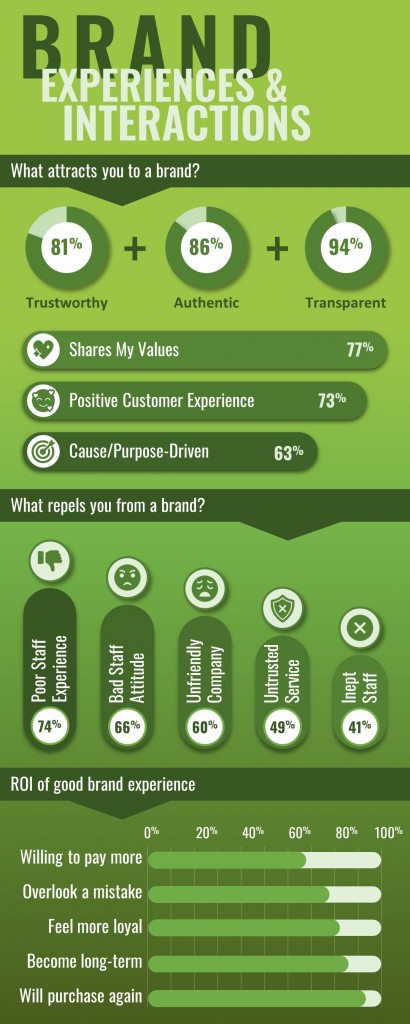5 Branding Mistakes That Might be Hurting Tradies’ Business – #5 Brand Experience

Have you ever had such a bad experience with a business that you will never go back? How many people did you tell about it? How can you make sure that your customers feel the same way with your brand?
Why is this important?
Lets start off with a few definitions of what brand experience is.
Oberlo say that branding is not just the logo you design, the font you use, or the products you sell. It’s all these things and much more. It’s the customer experience you provide. It’s the philosophy you embrace and the culture you adhere to. A brand is a feeling that a business evokes in customers—it’s what makes your business unique.
The Interaction Design Foundation suggest that brand experience is how the customer feels when engaging or interacting with a brand.
I really like this one from HubSpot… A brand identity is made up of what your brand says, what your values are, how you communicate your product, and what you want people to feel when they interact it. Essentially, your brand identity is the personality of your business and a promise to your customers.
An online printing company in New Zealand, creates an expectation in the mind of their customers – its their brand promise.
We are not just order takers. Our goal is to become an extension of your business…
Lucidpress believe that a brand exists only in the minds of your customers. Simply put, a brand is the sum total of all the impressions a customer has, based on every interaction they have had with you, your company and your products.
I would add that it is what your customers see, hear, smell, taste and experience when they do business with you. It’s how they feel before (anticipation), during (experience) and after (memory) interactions with you, your staff or your store.
How would your customers describe your brand?
If I surveyed the most recent 100 people who had an experience with your brand, how would they describe it?
- They are always on the job, on time and on price – fantastic
- They are always late, completely unreliable – I won’t use them again
- They are innovative and cutting edge – exciting
- The place is always dirty – urgh
- The guy was a bit sleazy – I couldn’t wait to leave
- Very sophisticated and elegant – prestigious
- They were so thoughtful and kind – caring
Did they have a good experience with your brand, or did they leave wishing for a better experience?
What makes a poor brand experience?
This question has been surveyed and written about countless times. And the message is clear and consistent.
People say they have had a poor experience with a brand when the following things happen on a regular basis. it might not even have been their own experience. If someone hears these things too often they automatically form a negative brand experience with a company.

Three quarters of consumers surveyed said that their negative interactions with staff included poor attitudes and lack of product or service knowledge. Consumers are also concerned about staff who lack understanding of individual needs, staff unavailability, and delivering products and services that don’t live up to expectations.
Only 29% of company employees surveyed agreed that these things are an issue.
That’s a huge difference in perception.
It is this difference in perception that destroys brand experience. How many times have you encountered staff that just don’t care what customers think?
What about staff who are late, unreliable, rude, messy, and who do a bad job – but don’t believe there is a problem. Or even worse, who blame the customer for “being fussy.”
“It takes 20 years to build a reputation and five minutes to ruin it. If you think about that, you’ll do things differently.” –Warren Buffett
It comes at a cost
Here are just some of the side effects of consistently bad customer service over time:
- Your reputation is damaged
- Leads don’t convert
- Customers move their business to a competitor
- Your Customer Lifetime Value Drops
- You Lose Your Best Employees
- Unhappy customers tell friends and family about their negative experience
- You lose money
How to repair the damage
- Make Amends. Have a key figure in your company reach out to those who have received bad customer service to make amends.
If necessary, responding publicly to negative reviews, accepting responsibility for the wrongdoing, and informing people that you’re solving the issues. Come clean. be quick to apologise.
However, make it a point to move this conversation to a private discussion – don’t engage in public warfare!
You must address the problems internally. Set a higher standard for customer service and make it a top priority until it’s become a permanent fixture in your operations.
Be quick to apologise and make amends - Be transparent when handling client issues. Transparency means telling the customer what happened so they understand the issue; don’t make up excuses.
- Capture feedback and measuring customer satisfaction.
When you do get negative feedback, ask, “What can we do to help?” But make sure you address the issue or you will lose the customer – and your reputation.
- Develop a customer retention strategy that builds brand loyalty, including:
– Webinars
– How-to videos and articles
– FAQ pages
– Special/exclusive deals
– Newsletters
- Reward your best employees and don’t keep bad employees around.
Great customer service starts with a great company culture.
Remember, what you permit – you promote! -
Prevention is better than cure. The best way to solve bad customer service is to prevent it, but the second best way is to get it corrected before it gets out of hand.
Create an amazing brand experience
1) Clarify your mission
Clarifying your mission is about defining why your organisation exists. Are you in business simply to make a profit? Increasingly consumers want you to have a more authentic and purpose-drive reason for existing.
I recently came across Christchurch electricians who are very clear about why they exist:
“Our genuine goal in the industry is to make the world a happier place through building an exceptional business.”
That’s fantastic. It is aspirational, meaningful, and gives clear guidance to both employees and customers. At the end of each day, employees can ask themselves, “did I make the world a happier place today? Were we exceptional in all that we did?”
2) Confirm your Core Values
Confirming your core values means identifying how the best people in your organisation behave. Who are the founders and heroes in your organisation? What do they stand for? How do they consistently behave in a way that you admire?
Their behaviours represent the values of the organisation – what is truly important.
Again, this tells employees what is expected of them.
The electrician I just mentioned is very clear on how he expects his team to behave.
We come on time, get the job done, and we leave no mess behind. We provide the right advice, exceptional communication, and outstanding administration. Our pricing is always clear and transparent – no surprise charges – and we guarantee the quality of our workmanship.
He believes in this so much that he turned it into a 7 point guarantee!
The point though, is that this becomes the brand experience for every customer. And they love it!
It starts with recruitment
Don’t train your employees to behave this way – employ people who have already demonstrated that they own these behaviours. And don’t let people stay if they do not embody the values.

No matter how desperate you are for another employee, if they don’t buy in to expected behaviours you will regret it – probably sooner rather than later. And we all know how hard it is to remove an undesirable empoyee.
Your core values should compel some people to join you, and repel the one that don’t belong.
Don’t make the job interview a discussion, make it into a demonstration of talent, and ensure it reveals underlying beliefs, attitudes and behaviours.
3) Communicate the importance of positive brand experience
The ROI of customer experience is actually quite staggering. Forbes reveal that:
- Customer-centric companies are 60% more profitable than companies that don’t focus on customers.
- Brands with superior customer experience bring in 5.7 times more revenue than competitors that lag in customer experience.
- 84% of companies that work to improve their customer experience report an increase in their revenue.
Again, by ensuring you only ever employ people who love to experience and deliver an exceptional brand experience, this should not be hard. But Patrick Lencioni creates a compelling case for over-communicating.
Leaders must purposefully overcommunicate in a way that resonates and sticks with others in the organization – Patrick Lencioni
This is an investment that will produce significant returns that you cannot afford to miss.
4) Create opportunities for customer engagement
Yes, I know you are busy, and don’t really need anything extra to do.
But from time to time, offer your customers the opportunity to see, hear, read about and talk about your product or service.
It doesn’t have to be very time consuming:
- A customer survey with a prize
- A referral voucher with a reward attached
- A competition
- Free samples
- A pop-up stand at a local mall or market day

5) Customise their experience
Consumers are consistently communicating that they don’t want an impersonal, generic, one-size-fits-all experience.
- They want to be known.
- They want to be understood.
- They want their specific needs to be met.
Yes, this is a tall order. But the companies that deliver reap the rewards.
It won’t be possible in every business, in every aspect of every interaction. But there will be some way that you can customise your product or service, or simply the experience they have with you.
- It might not be the product. it might be the greeting and the personalised follow up.
- It might be the reminder you send them in six months.
Don’t think of it as an expense. Think of it as marketing. Think of it as generating word of mouth referrals.
What people like, they repeat. What they love, they share with others.
Brainstorm. Get creative.
Have fun with it.
6) Craft the brand promise
If the brand experience is how your customers feel before (anticipation), during (experience) and after (memory) interactions with your brand, what is their (and your) current reality?
Take a moment to brainstorm with the heroes of your brand, through the entire brand experience from how customers find you, to their first pre-purchase contact with you, any waiting period or delay, the actual experience with you on the day, what happens afterwards, how you resolved problems or complaints, and so on.
Very intentionally, craft each of these and other stages within the context of your business.
7) Cultivate the Memory
Finally, what can you do, to make sure that long after their interaction with you, they remember you in positive ways?
It could be as simple as:
- A small gift
- A personalised email to thank them for their custom
- An unexpected bonus product or service
- A free upgrade?

It might not take long to create a memory that lasts a lifetime.
Conclusion
Crafting a brilliant brand experience creatively and consistently will take time and energy. it is much more demanding than simply putting an advert in the local rag.
It might even be risky.
But reward is often related to risk. Those who go the extra mile are often appreciated and rewarded. When you give more than is expected, you often receive more than you dreamed!
Have fun!
Get your business noticed by creating an online directory listing. Listings are FREE and you can create as many as you need.
- Get found by locals





